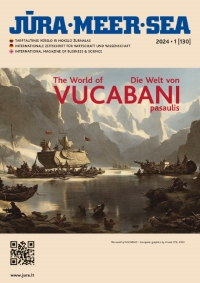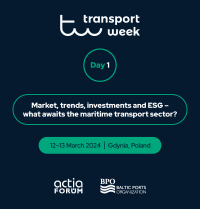Dr. Leonard Heilig

Research Project Manager at the University of Hamburg. A research group at the Institute of Information Systems is developing a digital twin for the port in its TwinSim project where dr. Heilig is a Project Leader Research.
In recent years, he has published more than 40 scientific articles and books and served as guest editor in the fields of logistics and cloud computing while also working as independent consultant on numerous international logistics projects.
Co-founder and CTO at driveMybox GmbH. As CTO, he leads the technical development of the platform, optimization, AI, and cloud infrastructure.
First of all, could you briefly describe what a digital twin is and give some examples of its uses in context of a seaport?
A digital twin virtually reflects real-world entities and their context, maintained through a continuous exchange of information. Compared to a digital shadow, the information flow of a digital twin is two-way, meaning that data-driven decisions and insights can be used to influence entities and their operations. In a recent survey, we found a variety of application areas in the port sector, ranging from infrastructure management to cargo handling and inventory management. Digital twins at the port level are typically employed to monitor and control infrastructure (e.g., bridges, streets, locks, traffic), measure environmental conditions (e.g., sources of pollution, weather impact), and visualize contextual information on movable and non-movable objects (e.g., vessels, buildings, construction sites). I believe that a huge potential lies in combining the different sources of information to get an overall picture of the seaport and conduct an in-depth analysis of cause-and-effect relationships and patterns, such as between landside and seaside traffic flows. These insights can be used to feed simulation models that aid infrastructure planning.
At the terminal level, we see various applications of digital twins to monitor and manage terminal equipment and operations. A digital twin can be used to enrich data from the terminal operating system (TOS) by combining it with data from physical objects, mirroring the real-time conditions on the ground. This integration facilitates precise operational measurements to analyze cause-and-effect relationships and what-if scenarios, support data-driven decision making, and optimize the use of resources in terms of productivity, resilience, and environmental impact.
The TwinSim Project is being worked on by the University of Hamburg in cooperation with the EUROGATE container terminal in Hamburg. What are the main goals of the initiative?
The primary goal is to develop and apply a digital twin for enhancing terminal operations and maintenance based on data-driven decision support. For this purpose, we have equipped staddle carriers and quay cranes with IoT devices to collect data directly from the equipment and sensors, transform it into a standardized TIC4.0 format, and combine it with TOS data and other external data sources (e.g., weather information) to reflect respective operational cycles. This is the basis for our 3D virtual container terminal, which visualizes the real objects, movements and contextual information in real-time to better monitor and analyze current activities. At the same time, we are building a data lake, where the collected data is further processed and analyzed using data analytics and machine learning, with applications such as predictive maintenance. The core of the digital twin is the simulation-based optimization, facilitating data-driven decision support. Our simulation model allows to emulate past shifts and to initiate a what-if analysis to simulate future scenarios and validate operational plans. The simulation model is further integrated with new optimization algorithms, enabling the testing of new planning strategies to enhance utilization of available equipment.
What where some of the biggest challenges you had to tackle in the initial phase of the project?
In the case of large projects like this, our initial priority was to secure the commitment of all relevant stakeholders and to ensure that the digital twin offers functionalities that enhance and support various activities, processes, and key use cases, while aligning with the terminal's overall strategy and goals. We devised a comprehensive procedure for collecting, detailing, prioritizing, and selecting use cases that the digital twin could materialize. From a technical perspective, it was crucial to ensure that the compatibility and comparability could be established between data from diverse equipment suppliers and TOS providers using data standards. In this regard, we decided to fully adopt the TIC4.0 data standards.
From your perspective, are digital twins a solution every port can profit from? What can port authorities do to better evaluate the feasibility of such an investment?
I believe the usefulness of a digital twin for ports and terminal really depends on how well it aids in solving problems, enhancing processes, and enabling data-driven decision making. As such, a digital twin can form a significant foundation for getting more out of collected and available data. If a digital twin is merely used for visualizing certain aspects in the port, its value may be quite limited. However, if it aids in gaining a better understanding about what is happening and what happened, why did something happen, what will happen and what can be done to improve the situation or mitigate certain scenarios, then I am confident that every port can benefit from a digital twin.
In the initial phase of our project, we conducted a use-value analysis to select identified use cases. This was based on a detailed description of specific criteria, including potential process and safety improvements, potential cost savings, estimated implementation costs and time, scalability and extensibility, environmental impacts, and strategic relevance. From my perspective, this analysis is crucial in assessing the viability of such an investment. Once again, if the sole purpose is to visualize certain aspects in real-time, the effort required to implement a digital twin might outweigh the benefits.
Environmental responsibility is a topic that has been becoming increasingly more important for ports, with numerous regulations either already in force or coming into force very soon. Can a digital twin help ports meet the goals set for them by the policymakers?
Digital twins can help in several ways. Firstly, they provide a foundation for accurately measuring and visualizing environmental impacts, such as greenhouse gas emissions, noise, or water pollution. Leveraging this information, ports and terminals can establish emission inventories and environmental performance indicators. In our project, for example, we track the energy consumption of equipment for every move and can analyze it at different levels, for example, to precisely calculate the total energy consumed by a specific container throughout its time at the terminal.
Secondly, as previously mentioned, digital twins establish a basis for data-driven decision support: Understanding cause-and-effect relationships, such as the correlation between landside and seaside traffic flows, while considering concrete data about environmental impacts, could aid in enhancing infrastructure planning and traffic management, for example, to avoid congestion. By sharing data among port community members and shipping companies, operations and activities could be better arranged, thus enabling concepts like slow steaming.
Source, Ports 4.0










